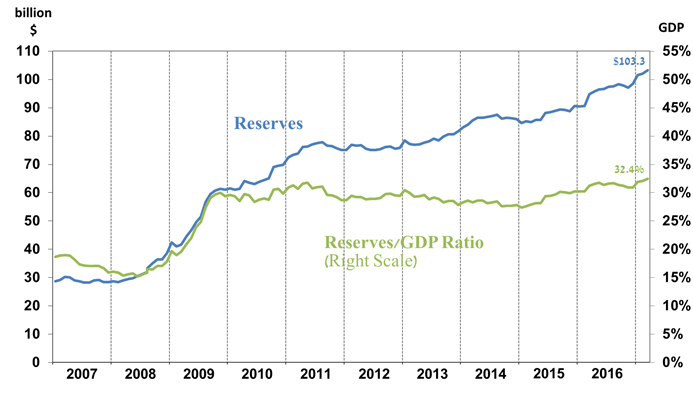The increase was the result of:
a. Foreign currency purchases by the Bank of Israel totaling $1,585 million
b. A revaluation[1] that increased the reserves by about $549 million.
The increase was offset by:
c. Government transfers to abroad totaling about $649 million.
d. Private sector transfers of about $214 million.
Israel's Foreign Exchange Reserves
$ million
|
Date |
Reserves bought under the natural gas purchase program |
Reserves excluding IMF (including reserves bought under the natural gas purchase program) |
Reserves at the IMF[2] |
Total Foreign Exchange Reserves |
|
March 2016 |
9,300 |
93,476c |
1,304 |
94,780c |
|
April 2016 |
9,300 |
94,378c |
1,306 |
95,684c |
|
May 2016 |
9,600 |
95,170 |
1,293 |
96,463 |
|
June 2016 |
9,600 |
95,594 |
1,041 |
96,635 |
|
July 2016 |
9,900 |
96,356 |
1,037 |
97,393 |
|
August 2016 |
9,900 |
96,588 |
1,038 |
97,626 |
|
September 2016 |
9,900 |
97,380c |
1,049 |
98,429c |
|
October 2016 |
10,200 |
96,931 |
1,032 |
97,963 |
|
November 2016 |
10,200 |
95,948 |
1,179 |
97,127 |
|
December 2016 |
10,500 |
97,275c |
1,172c |
98,447c |
|
January 2017 |
10,500 |
100,428c |
1,183 |
101,611c |
|
February 2017 |
10,750 |
100,841 c |
1,179 |
102,020c |
|
March 2017 |
10,750 |
102,109 |
1,182 |
103,291 |
Figure 1
Level of foreign exchange reserves, and their ratio to GDP, 2007–17

 Graphs and Data
Graphs and Data[1] This includes Bank of Israel payments and receipts in foreign currency.
[2] This column includes Special Drawing Rights (SDRs), the balance of NAB loans, and the balance of Israel's reserve tranche in the IMF.
c Updated after the original date of publication.